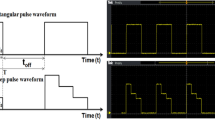Abstract
Electrochemical micromachining (EMM) has become a popular technology for fabricating microscale structures. To obtain higher machining localization and minor stray corrosion, a new hybrid EMM process combining air assistance and ultrasonic assistance was introduced in this paper. Simulations and experimental investigations were conducted to study the influencing mechanism and the influencing characteristics of the assisting process energies. In the multi-physics model, a reactant transport model is included, and the direct coupling between the assisting processes and the electrochemical process is achieved. Results indicate that, when the two assisting processes are applied separately, the assisting effect tend to act on the entire workpiece surface, either promotes the overall dissolution or inhibits it, usually leading to unsatisfactory results; by combining the two assisting processes, synergistic effect occurs: dissolution in the central area is promoted by the ultrasonic assistance, while stray corrosion in the margin area is hindered by the air assistance. Thus, microstructures with enhanced aspect ratio and reduced stray corrosion can be fabricated. The results also show that the surrounding airflow can produce an electrical insulating effect on both the workpiece and the cathode. When the air pressure is low, an additional concentrating effect on the electric field can be observed; however, a high air pressure leads to a greatly hindered dissolution. When the applied amplitude is appropriate, ultrasonic assistance promotes the electrochemical dissolution through disturbance effect and cavitation phenomena. But if the amplitude is too large, massive cavitation bubbles will inhibit the dissolution greatly.




















Similar content being viewed by others
References
Saxena KK, Qian J, Reynaerts D (2018) A review on process capabilities of electrochemical micromachining and its hybrid variants. INT J MACH TOOL MANU 127:28–56. https://doi.org/10.1016/j.ijmachtools.2018.01.004
Kock M, Kirchner V, Schuster R (2003) Electrochemical micromachining with ultrashort voltage pulses–a versatile method with lithographical precision. ELECTROCHIM ACTA 48(20):3213–3219. https://doi.org/10.1016/S0013-4686(03)00374-8
Chen C, Li J, Zhan S, Yu Z, Xu W (2016) Study of micro groove machining by micro ECM. Procedia CIRP 42:418–422. https://doi.org/10.1016/j.procir.2016.02.224
Ghoshal B, Bhattacharyya B (2015) Vibration assisted electrochemical micromachining of high aspect ratio micro features. PRECIS ENG 42:231–241. https://doi.org/10.1016/j.precisioneng.2015.05.005
Kim BH, Na CW, Lee YS, Choi DK, Chu CN (2005) Micro electrochemical machining of 3D micro structure using dilute sulfuric acid. CIRP ANN-MANUF TECHN 54(1):191–194. https://doi.org/10.1016/S0007-8506(07)60081-X
Rathod V, Doloi B, Bhattacharyya B (2017) Fabrication of microgrooves with varied cross-sections by electrochemical micromachining. INT J ADV MANUF TECH 92(1):505–518. https://doi.org/10.1007/s00170-017-0167-7
Chavoshi SZ, Luo X (2015) Hybrid micro-machining processes: a review. PRECIS ENG 41:1–23. https://doi.org/10.1016/j.precisioneng.2015.03.001
Lauwers B, Klocke F, Klink A, Tekkaya AE, Neugebauer R, McIntosh D (2014) Hybrid processes in manufacturing. CIRP ANN-MANUF TECHN 63(2):561–583. https://doi.org/10.1016/j.cirp.2014.05.003
Hackert, M., Meichsner, G., & Schubert, A. (2008). Generating micro geometries with air assisted jet electrochemical machining. Paper presented at the Proceedings of the 10th Anniversary International Conference of the European Society for Precision Engineering and Nanotechnology.
Kai S, Sai H, Kunieda M, Izumi H (2012) Study on electrolyte jet cutting. Procedia CIRP 1:627–632. https://doi.org/10.1016/j.procir.2012.05.011
Goel, H., & Pandey, P. (2015, 2014). Experimental investigations into micro-drilling using air assisted jet electrochemical machining. Paper presented at the 5th International & 26th All India Manufacturing Technology, Design and Research Conference, IIT Guwahati, Assam, India.
Hu X, Zhu D, Li J, Gu Z (2019) Flow field research on electrochemical machining with gas film insulation. J MATER PROCESS TECH 267:247–256. https://doi.org/10.1016/j.jmatprotec.2018.12.019
Wang MH, Bao ZY, Qiu GZ, Xu XF (2017) Fabrication of micro-dimple arrays by AS-EMM and EMM. INT J ADV MANUF TECH 93(1–4):787–797. https://doi.org/10.1007/s00170-017-0538-0
Yang I, Park MS, Chu CN (2009) Micro ECM with ultrasonic vibrations using a semi-cylindrical Tool. INT J PRECIS ENG MAN 10(2):5–10. https://doi.org/10.1007/s12541-009-0020-5
Mitchell-Smith J, Clare AT (2016) Electrochemical jet machining of titanium: overcoming passivation layers with ultrasonic assistance. In: Kunieda M, Okada A, Furutani A (eds) 18th Cirp Conference on Electro Physical and Chemical Machining, vol 42. Elsevier Science Bv, Amsterdam, pp 379–383
Patel JB, Feng ZJ, Villanueva PP, Hung WNP (2017) Quality enhancement with ultrasonic wave and pulsed current in electrochemical machining. In: Wang L, Fratini L, Shih AJ (eds) 45th Sme North American Manufacturing Research Conference, vol 10. Elsevier Science Bv, Amsterdam, pp 662–673
Natsu W, Nakayama H, Yu ZY (2012) Improvement of ECM characteristics by applying ultrasonic vibration. INT J PRECIS ENG MAN 13(7):1131–1136. https://doi.org/10.1007/s12541-012-0149-5
Skoczypiec S (2011) Research on ultrasonically assisted electrochemical machining process. INT J ADV MANUF TECH 52(5–8):565–574. https://doi.org/10.1007/s00170-010-2774-4
Fang X, Qu N, Zhang Y, Xu Z, Zhu D (2014) Effects of pulsating electrolyte flow in electrochemical machining. J MATER PROCESS TECH 214(1):36–43. https://doi.org/10.1016/j.jmatprotec.2013.07.012
Chen XL, Fan GC, Lin CH, Dong BY, Guo ZN, Fang XL, Qu NS (2020) Investigation on the electrochemical machining of micro groove using masked porous cathode. J MATER PROCESS TECH 276:116406. https://doi.org/10.1016/j.jmatprotec.2019.116406
Wang M, Zhang Y, He Z, Peng W (2016) Deep micro-hole fabrication in EMM on stainless steel using disk micro-tool assisted by ultrasonic vibration [J]. J MATER PROCESS TECH 229:475–483
Funding
This research was funded by [National Natural Science Foundation of China] grant numbers [51975532] and [Open Fund of Key Laboratory of Special Purpose Equipment and Advanced Processing Technology, Ministry of Education and Zhejiang Province] grant numbers [EM2019120101].
Author information
Authors and Affiliations
Contributions
Xindi Wang—Simulation, experimental and writing; Minghuan Wang— Reviewing and editing; Yongchao Shang— Experimental.
Corresponding author
Ethics declarations
Ethics approval
The authors declare compliance with ethical standards.
Consent to participate
The authors consent to participate.
Consent for publication
The authors content to publish.
Conflict of interest
The authors declare no competing interests.
Additional information
Publisher's note
Springer Nature remains neutral with regard to jurisdictional claims in published maps and institutional affiliations.
Rights and permissions
About this article
Cite this article
Wang, X., Wang, M. & Shang, Y. A study of air/ultrasonic co-assisted electrochemical micromachining. Int J Adv Manuf Technol 118, 1903–1918 (2022). https://doi.org/10.1007/s00170-021-08041-y
Received:
Accepted:
Published:
Issue Date:
DOI: https://doi.org/10.1007/s00170-021-08041-y




